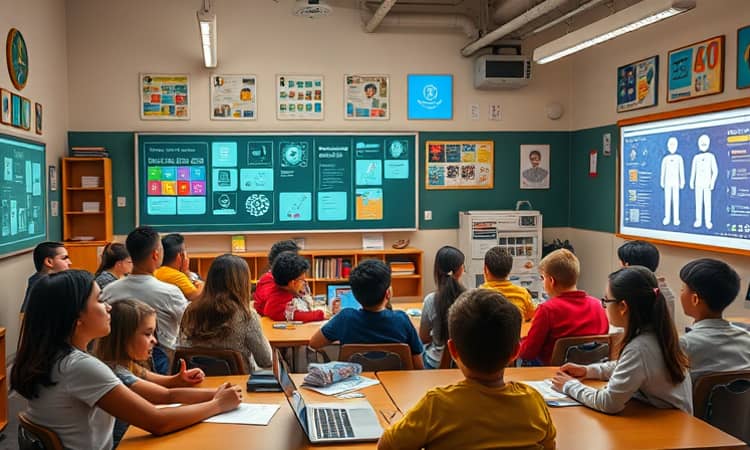In the past decade, technology has reshaped the way we learn and teach, but nowhere is its impact more profound than in the realm of artificial intelligence. As algorithms grow more sophisticated, AI-driven platforms are revolutionizing classrooms, online courses and educational tools across all levels. From early childhood settings to higher education, AI provides educators and learners with powerful resources that adapt, support and inspire. This article explores how these advancements are forging a new era of teaching with unprecedented potential.
By analyzing vast amounts of data gleaned from student interactions, AI systems are unlocking insights into individual learning patterns. This data empowers educators to offer precisely tailored instruction, ensuring that no student is left behind or unchallenged. As we examine the major innovations, we will see how AI is not replacing teachers, but augmenting their strengths and enabling a richer, more effective educational experience.
Personalized and Adaptive Learning
One of the most celebrated benefits of AI in education is the ability to deliver highly personalized learning experience to each student. Adaptive learning platforms assess a learner’s pace, style and knowledge gaps in real time, then adjust content accordingly. By doing so, they minimize frustration and boost motivation, creating an environment where students progress at an optimal rhythm.
These systems gather data points such as quiz results, reading speed and engagement metrics. Through advanced analytics, they curate practice exercises and multimedia resources that align with each student’s unique profile. UNESCO’s 2023 Global Education Monitoring Report highlights the critical role of digital tools in customizing education for diverse needs and abilities, underscoring the global push toward individual-centered learning models.
- Tailoring content to individual strengths
- Providing targeted remediation for weaknesses
- Maintaining optimal challenge levels
- Encouraging ongoing motivation and focus
Intelligent Tutoring Systems
AI-powered Intelligent Tutoring Systems (ITS) simulate the benefits of one-on-one instruction by offering real-time feedback and support to students. Virtual tutors can detect missteps, clarify misunderstandings and suggest alternative strategies, all within seconds. This immediacy of guidance mirrors personalized human tutoring—and in some cases extends it beyond traditional classroom hours.
Various ITS platforms employ natural language processing to interpret student questions and machine learning models to predict areas of difficulty. As a result, learners receive tailored hints and adaptive prompts that guide them toward mastery. Many institutions report significant gains in student performance when supplementing teachers with these virtual assistants, demonstrating the synergy between human expertise and AI capabilities.
Automation of Administrative Tasks
Teaching involves a considerable volume of paperwork, from grading assignments to tracking attendance and documenting progress. AI alleviates these burdens by automating routine tasks, significantly reducing teacher workload. Platforms like Gradescope use image recognition and pattern analysis to grade exams, essays and problem sets with remarkable accuracy, freeing educators to focus on instruction and relationship-building.
Research shows that Gradescope can cut grading time by up to 70%. Teachers reclaim hours previously spent on rote tasks to design creative lessons, hold one-on-one consultations and engage in professional development. This shift not only enhances instructional quality but also improves teacher well-being and job satisfaction.
Early Intervention and Student Support
Predictive analytics is transforming how schools identify learners at risk of falling behind. By monitoring attendance, grades and engagement levels, AI systems can flag warning signs days or even weeks before performance declines become critical. This enables precise early intervention measures, guiding counselors and instructors to offer timely assistance.
At Ivy Tech Community College, an AI pilot program identified 16,000 at-risk students early in the semester. Through personalized outreach, tutoring and resource referrals, 3,000 of those students avoided failing, with 98% achieving a grade of C or better. Such outcomes highlight the life-changing potential of data-driven strategies in education.
Inclusive and Accessible Education
AI tools are increasingly designed to support learners with diverse needs. Speech-to-text and text-to-speech technologies empower students with visual or hearing impairments, while AI-driven captioning makes audio content accessible. Language translation features facilitate collaboration among multilingual groups, effectively breaking down language barriers in international classrooms.
Moreover, AI can adapt content presentation for neurodiverse learners, adjusting font size, color contrasts and pacing to accommodate attention and processing differences. These innovations are vital steps toward ensuring that every student, regardless of ability or background, has the opportunity to succeed.
Gamification and Engagement
Learning games powered by AI algorithms combine entertainment with education, boosting engagement and retention. Through innovative immersive educational game design, students tackle challenges, solve puzzles and collaborate in virtual environments that reinforce core concepts. These experiences cater to the rising generation of digital natives, who thrive on interactive and social learning formats.
Projects funded by the National Science Foundation illustrate how AI-driven games teach complex topics like machine learning to high schoolers, blending real-world examples with playful interfaces. Such initiatives demonstrate that gamification is more than distraction; when designed responsibly, it deepens understanding and fosters a genuine love of learning.
Teaching AI and Digital Literacy
As AI becomes integral to society, students must learn not only with AI but also about AI. Curricula now incorporate modules on algorithmic thinking, data ethics and responsible technology use. By demystifying AI concepts, educators equip learners with critical thinking skills for future careers and prepare them for a world where digital literacy is as essential as reading and writing.
Many districts are partnering with universities and tech companies to deliver AI workshops, coding camps and hackathons, ensuring that students gain hands-on experience with machine learning tools. Such collaborations bridge the gap between theoretical knowledge and practical application, fostering innovation and entrepreneurship.
Challenges and Considerations
Despite its promise, AI integration raises important questions about equity, ethics and the preservation of human connection. Key concerns include:
- Ensuring equitable access to technology and infrastructure
- Maintaining strong teacher-student relationships
- Preventing bias and safeguarding academic integrity
Closing the digital divide is paramount; without reliable internet and devices, marginalized communities risk being left further behind. Ethical guidelines must steer AI development toward inclusivity and fairness, while educators need training to balance automated tools with empathy-driven instruction.
Future Directions and Policy Implications
Organizations like UNESCO and the U.S. Department of Education are crafting guidelines to support responsible AI adoption in schools. Priorities include data privacy, transparency and culturally responsive design. Policymakers advocate for:
- Investment in digital infrastructure and teacher training
- Collaborative frameworks among educators, technologists and communities
- Continuous evaluation of AI’s impact on learning outcomes
As we look ahead, it is essential to foster an ecosystem where AI serves as a partner in education. By combining machine efficiency with human creativity and compassion, we can unlock new heights of learning, nurture potential and cultivate a generation equipped to tackle the world’s greatest challenges.
Conclusion
Artificial intelligence stands as a transformative force in education, offering tools and insights that were unimaginable only a few years ago. From personalized learning journeys and virtual tutors to game-based experiences and early intervention systems, AI paves the way for more inclusive, engaging and effective education. However, realizing this potential requires thoughtful integration, ethical stewardship and a steadfast commitment to equity.
When educators, policymakers and technologists join forces, AI can amplify human strengths rather than supplant them. In doing so, we honor the timeless values of mentorship, curiosity and collaboration—while harnessing cutting-edge innovation to prepare every learner for a bright future.
References
- https://onlineprograms.education.uiowa.edu/blog/role-of-ai-in-modern-education
- https://er.educause.edu/articles/2024/1/will-our-educational-system-keep-pace-with-ai-a-students-perspective-on-ai-and-learning
- https://www.nsf.gov/science-matters/ai-education-ai-education
- https://www.unesco.org/en/digital-education/artificial-intelligence
- https://learningsciences.smu.edu/blog/artificial-intelligence-in-education
- https://www.aiprm.com/ai-in-education-statistics/
- https://languagemagazine.com/2023/05/31/the-importance-of-artificial-intelligence-in-education-for-all-students/














